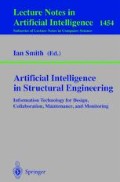Abstract
The purpose of this paper is to address the following questions:
-
• Can expert systems be integrated into design procedures of a structural design office at reasonable cost, in a short period of time and in a way that can be accepted by the practising engineer?
-
• How usefulness can be the adoption of suitable expert systems?
-
• What procedures are most suited to reach these goals?
For this purpose, the experience accumulated by the authors in recent years is exposed from the point of view of the structural engineer rather than from the one of the Al scientist. The key to the success seems to lie in the following points:
-
• An adequate data base must be collected concerning existing structures according to a suitable format .
-
• Knowledge should be extracted from this data base using as far as possible an automatic self instructing procedure based on neural networks
-
• The inference procedure should as far as possible imitate the way of reasoning of the structural engineer.
-
• The system should be integrated in a CAD environment.
Preview
Unable to display preview. Download preview PDF.
References
Dayhoff J., Neural Network Architectures, Van Nostrand Reinhold,New York, 1990
Maher M.L., Fenves S.J., HI-RISE: an expert system for preliminary design of High Rise buildings, Technical Report, Dept of Civil Engineering, Carnegie Mellon University, 1984
Fenves S J, Maher M.L., Sriram D., Knowledge based expert systems in Civil Engineering”, IABSE Periodica, Number 4, 1985
Fenves S J, Expert systems, Expectations versus realities, Proceedings of IABSE Colloquium “ Expert Systems in Civil Engineering”, Bergamo 1989.
Cauvin A, Stagnitto G., Classification of Structures and organization of hypermedia data bases for Structural Design, First workshop of EG-SEA-AI, EPFL, Lausanne 1994.
Cauvin A, Stagnitto G., A “Model Oriented” Expert system for the preliminary design of bridge structures, First workshop of EG-SEA-AI, EPFL, Lausanne 1994.
Tong C, Sriram,Artificial Intelligence in Engineering Design, Vol. l, chapt.1, introduction, Academic Press Inc., 1992
Faltings B, Reasoning Strategies for Engineering Problems, Proceedings of IABSE Colloquium “Knowledge Based Systems in Civil Engineering”, Bejing 1993.
Steinberg L, Design as Top Down Refinement Plus Constraint Propagation, from Chapter 8 of book: Artificial Intelligence in Engineering Design, Vol. l, Academic Press Inc., 1992
Cauvin A., Stagnitto G., Framework of a general purpose expert system for preliminary structural design. Proceedings of IABSE COLLOQUIUM, Bergamo, 1995, Session 1-Knowledge support for Structural Design and Construction
Cauvin A., Passera R., Stagnitto G., Collection of relevant data and definition of a knowledge base for structural design using expert systems. Proceedings of IABSE COLLOQUIUM, Bergamo, 1995
Cauvin A, Stagnitto G. A “Top down” procedure for preliminary design of Tall Building Structures using expert systems. Proceedings of the World Conference on Tall Buildings and Urban Habitat, Amsterdam 1995.
Cauvin A, Use of Neural Networks for Preliminary Structural Design,Proceedings of the 6th International Conference on Computing in Civil and Building Engineering, Berlin, Germany. Published by Balkema 1995.
Author information
Authors and Affiliations
Editor information
Rights and permissions
Copyright information
© 1998 Springer-Verlag Berlin Heidelberg
About this chapter
Cite this chapter
Cauvin, A., Passera, R., Stagnitto, G. (1998). Integration of expert systems in a structural design office. In: Smith, I. (eds) Artificial Intelligence in Structural Engineering. Lecture Notes in Computer Science, vol 1454. Springer, Berlin, Heidelberg. https://doi.org/10.1007/BFb0030466
Download citation
DOI: https://doi.org/10.1007/BFb0030466
Published:
Publisher Name: Springer, Berlin, Heidelberg
Print ISBN: 978-3-540-64806-2
Online ISBN: 978-3-540-68593-7
eBook Packages: Springer Book Archive

